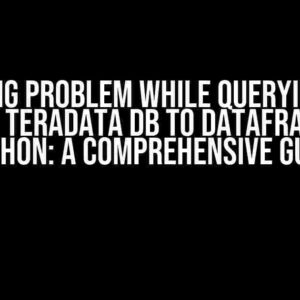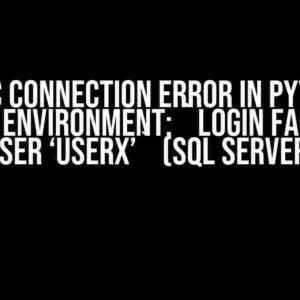If you’re reading this, chances are you’ve stumbled upon the notorious “can’t adapt type ‘dict'” error when trying to insert a dictionary into a table using psycopg2.sql. Don’t worry, you’re not alone! This error can be frustrating, especially when you’re new to working with PostgreSQL and Python. In this article, we’ll explore the reasons behind this error, and more importantly, provide you with clear and concise steps to overcome it.
What’s Causing the “can’t adapt type ‘dict'” Error?
Before we dive into the solution, let’s understand what’s causing this error. The “can’t adapt type ‘dict'” error occurs when psycopg2.sql, the PostgreSQL adapter for Python, is unable to convert a Python dictionary into a format that can be inserted into a PostgreSQL table. This error typically arises when you’re trying to insert a dictionary directly into a table using the `execute()` or `executemany()` methods.
A Quick Refresher on psycopg2.sql
psycopg2.sql is a powerful library that allows you to interact with PostgreSQL databases from Python. It provides a convenient way to execute SQL queries, fetch results, and perform other database operations. When working with psycopg2.sql, you need to ensure that the data you’re trying to insert is in a format that PostgreSQL can understand.
Solving the “can’t adapt type ‘dict'” Error
Now that we’ve identified the root cause of the issue, let’s explore the solutions. We’ll cover three approaches to overcome the “can’t adapt type ‘dict'” error:
- Using the `psycopg2.extras.execute_values()` function
- Converting the dictionary to a tuple
- Using the `jsonb` data type
Approach 1: Using the `psycopg2.extras.execute_values()` function
The `psycopg2.extras.execute_values()` function is a convenient way to insert multiple rows into a table using a single SQL statement. By using this function, you can pass a list of dictionaries, where each dictionary represents a row to be inserted.
import psycopg2.extras
import psycopg2
# Establish a connection to the database
conn = psycopg2.connect(
dbname="mydatabase",
user="myuser",
password="mypassword",
host="localhost"
)
# Create a cursor object
cur = conn.cursor()
# Define the SQL query
insert_query = "INSERT INTO mytable (column1, column2, column3) VALUES %s"
# Define the data to be inserted
data = [
{'column1': 'value1', 'column2': 'value2', 'column3': 'value3'},
{'column1': 'value4', 'column2': 'value5', 'column3': 'value6'},
# ...
]
# Use execute_values() to insert the data
psycopg2.extras.execute_values(cur, insert_query, [tuple(row.values()) for row in data])
# Commit the changes
conn.commit()
# Close the cursor and connection
cur.close()
conn.close()
In this example, we define a list of dictionaries, where each dictionary represents a row to be inserted into the `mytable` table. We then use the `execute_values()` function to execute the SQL query, passing the list of tuples as an argument.
Approach 2: Converting the dictionary to a tuple
In this approach, we convert the dictionary to a tuple using the `.values()` method. This allows us to pass the tuple as an argument to the `execute()` method.
import psycopg2
# Establish a connection to the database
conn = psycopg2.connect(
dbname="mydatabase",
user="myuser",
password="mypassword",
host="localhost"
)
# Create a cursor object
cur = conn.cursor()
# Define the SQL query
insert_query = "INSERT INTO mytable (column1, column2, column3) VALUES (%s, %s, %s)"
# Define the data to be inserted
data = {'column1': 'value1', 'column2': 'value2', 'column3': 'value3'}
# Convert the dictionary to a tuple
data_tuple = tuple(data.values())
# Execute the SQL query
cur.execute(insert_query, data_tuple)
# Commit the changes
conn.commit()
# Close the cursor and connection
cur.close()
conn.close()
In this example, we define a dictionary `data` that contains the values to be inserted into the `mytable` table. We then convert the dictionary to a tuple using the `.values()` method and pass the tuple as an argument to the `execute()` method.
Approach 3: Using the `jsonb` data type
If you’re working with JSON data, you can take advantage of the `jsonb` data type in PostgreSQL. This data type allows you to store JSON data in a column, and psycopg2.sql provides built-in support for it.
import psycopg2
import json
# Establish a connection to the database
conn = psycopg2.connect(
dbname="mydatabase",
user="myuser",
password="mypassword",
host="localhost"
)
# Create a cursor object
cur = conn.cursor()
# Define the SQL query
insert_query = "INSERT INTO mytable (data) VALUES (%s::jsonb)"
# Define the data to be inserted
data = {'column1': 'value1', 'column2': 'value2', 'column3': 'value3'}
# Convert the dictionary to a JSON string
data_json = json.dumps(data)
# Execute the SQL query
cur.execute(insert_query, (data_json,))
# Commit the changes
conn.commit()
# Close the cursor and connection
cur.close()
conn.close()
In this example, we define a dictionary `data` that contains the values to be inserted into the `mytable` table. We then convert the dictionary to a JSON string using the `json.dumps()` function and pass it as an argument to the `execute()` method, casting it to the `jsonb` data type.
Conclusion
The “can’t adapt type ‘dict'” error can be frustrating, but with these three approaches, you should be able to overcome it and successfully insert dictionaries into a PostgreSQL table using psycopg2.sql. Remember to choose the approach that best fits your use case, and don’t hesitate to reach out if you have any further questions or concerns.
Best Practices
To avoid running into similar issues in the future, keep the following best practices in mind:
- Always check the psycopg2.sql documentation for the latest information on supported data types and functions.
- Use the `psycopg2.extras.execute_values()` function for bulk inserts, as it provides better performance and convenience.
- Convert dictionaries to tuples or JSON strings when inserting data into PostgreSQL tables.
Troubleshooting Tips
If you encounter any issues while implementing these solutions, try the following troubleshooting tips:
- Verify that you’re using the correct psycopg2.sql version and that it’s compatible with your Python version.
- Check the PostgreSQL server logs for any error messages or warnings.
- Use the `psycopg2.errors` module to catch and handle specific exceptions related to data type conversions.
By following these tips and best practices, you’ll be well on your way to successfully working with psycopg2.sql and PostgreSQL.
| Approach | Description |
|---|---|
| Using `psycopg2.extras.execute_values()` | Insert multiple rows using a single SQL statement |
| Converting the dictionary to a tuple | Convert the dictionary to a tuple using the `.values()` method |
| Using the `jsonb` data type | Store JSON data in a column using the `jsonb` data type |
Here are the 5 questions and answers about the error “can’t adapt type ‘dict'” when inserting a dictionary into a table using psycopg2.sql:
Frequently Asked Question
Having trouble inserting dictionaries into your PostgreSQL database using psycopg2.sql? Don’t worry, we’ve got you covered! Check out these frequently asked questions to get back on track.
What causes the “can’t adapt type ‘dict'” error?
This error occurs when psycopg2 tries to insert a dictionary directly into a PostgreSQL table without proper conversion. By default, psycopg2 doesn’t know how to handle dictionary data types, hence the error.
How can I convert a dictionary to a suitable format for insertion?
You can convert your dictionary to a tuple or a list of tuples, depending on the structure of your table. For example, if your table has two columns, you can use the `zip` function to create a list of tuples: `insert_data = list(zip(dict.keys(), dict.values()))`.
What if I have a nested dictionary or complex data structure?
In that case, you may need to use the `jsonb` data type in PostgreSQL, which allows you to store JSON data. You can use the `json.dumps()` function to convert your nested dictionary to a JSON string, and then insert it into the `jsonb` column.
Can I use placeholders in my SQL query to prevent SQL injection?
Absolutely! You can use placeholders in your SQL query, such as `%s`, and then pass your dictionary values as a separate argument to the `execute()` method. This helps prevent SQL injection attacks and ensures that your data is properly escaped.
What if I’m using an ORM like SQLAlchemy?
If you’re using an ORM like SQLAlchemy, you can use its built-in support for dictionaries and JSON data types. SQLAlchemy will handle the conversion and insertion of your data for you, making it easier to work with complex data structures.



